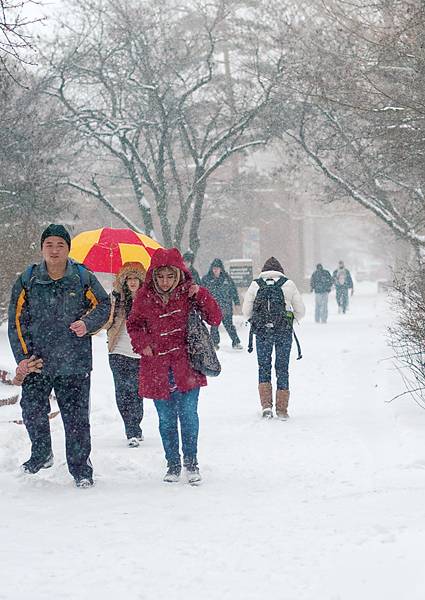El Nino expected to bring warmer temperatures shortly

Students walk through snowfall on Dec. 8, 2009, near the Landscape Architecture building. Temperatures are expected to rise in the coming weeks. File photo: Karuna Ang/Iowa State Daily
January 11, 2010
By Sarah Gonzalez
Daily Staff Writer
This season’s cold winter weather is expected to warm up during the next two weeks. Temperatures will reach 30–40 degrees Fahrenheit due to El Nino.
“The upcoming weeks will be a lot more normal for an El Nino winter,” said William Gallus, professor in geological and atmospheric sciences.
El Nino historically occurs every seven years; but the cycle has lately presented itself more often, or about every three years, said Elwynn Taylor, professor in agronomy.
The climate pattern, which originates in the Pacific, usually brings warmer temperatures to the Midwest if it occurs during the winter.
The rest of this winter is expected to be typical for an El Nino season.
The temperatures in the last month have been 15–20 degrees below average, however the next few weeks will bring in warmer temperatures roughly six degrees above normal, said Taylor.
Although El Nino historically lasts about 14 months, its lifetime has dwindled to about three months in recent years. This year’s cycle will be gone by June, said Taylor.
The past three winters have brought harsh temperatures, and the start of this season was no exception.
“The awful storm that lasted a month got here before El Nino started,” said Taylor.
The storm that brought heavy precipitation and snowed in ISU students had arrived before the climate reached El Nino level on Dec. 16.
Before mid-December, the season had followed the recent years’ trend of extremely cold winters.
“We are not really surprised to see three increasingly harsh winters,” said Taylor.
The North Atlantic oscillation has brought a cycle of unusually cold winters to the Midwest. The northern movements of the Gulf Stream have a substantial impact on Iowa’s winters, said Taylor.
The arrival of El Nino is predicted to turn this unusually harsh winter into an unusually warm one.
Tuesday and Wednesday have anticipated temperatures approximately 20–30 degrees Fahrenheit. However, wind chill values may be as low as -15 on Tuesday and 5 on Wednesday, according to the National Weather Service.
Meteorologists and the NWS Web site predict temperatures to consistently rise during the next week.
A “March-like weather pattern” is anticipated for the rest of the season, said Gallus.
However, he cautioned that flooding and icy conditions are potential hazards the warmer weather pattern could bring. Warm temperatures could melt most of the snow, causing floods.
If rain arrives while snow is still keeping air near the ground cold, it will freeze into ice.






